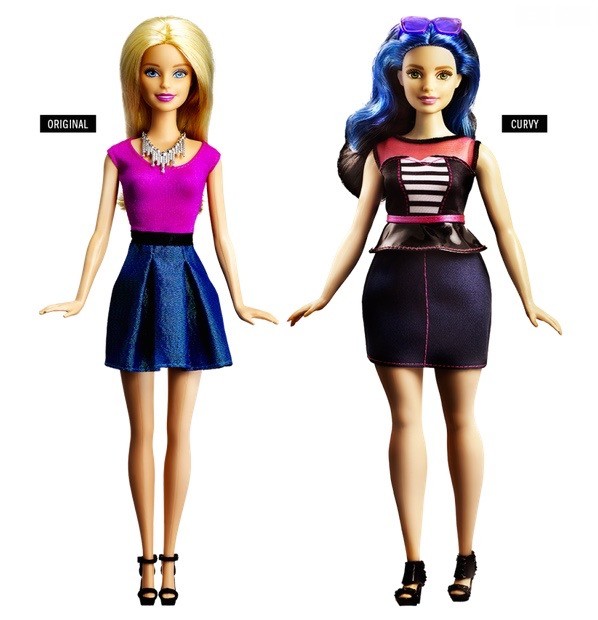#bodypositive #selfesteem #acceptance #TheDollEvolves
Mattel announced just last week the release of 3 new Barbies: Tall, Petite, and Curvy.
While the doll has undergone small changes over the years, this by far represents Barbie’s most drastic and important change to date.
Barbie has become a “symbol of American beauty” and an “aspirational role model” for young girls all over the globe. Barbie is so popular among young American girls it’s estimated that 99% between the ages of 3 and 10 own at least one Barbie.
But there’s been a serious problem. At the center of controversy for years, has been Barbie’s thin and disproportionate figure, which portrays an unrealistic and unattainable standard of beauty for females. Not only that, the ideal she embodies has been linked through several studies with a high occurrence of body dissatisfaction, low self-esteem, and disordered eating.
Despite the research, some have defended Barbie, saying that the doll can’t possibly have such an influence on young girls and that other socio-cultural factors must be to blame.
The study
In 2006, Dittmar, Halliwell, & Ive conducted a study to gain deeper insights into the factors that play a role in influencing body satisfaction and self-esteem. They also sought to find out just how early these types of perceptions begin to form in females. The study included girls between the ages of 5- and 8-years old. In one group girls were presented with images of a Barbie. In the other group, girls were shown images of a doll with a body shape and size closely representative of the average American woman.
After viewing the images, the girls answered a series of questions about their perceptions regarding body satisfaction and self-esteem.
The results
Girls who viewed the images of Barbie reported higher levels of body dissatisfaction and lower levels of self-esteem. Conversely, girls exposed to the doll with the average body type reported lower levels of body dissatisfaction and higher levels of self-esteem.
How we got here
A push for beauty standards over the years to evolve towards more realistic ones and those recently undertaken by body image advocates like Lena Dunham, the beginnings of cultural acceptance of the curvaceous body type as seen more in the media (think Beyonce, Kim K., Kristina Hendricks), and research supporting the value of taking a body positive approach with young girls is how we got here, and it’s why she’s finally here!
In a statement made by Evelyn Mazzocco, senior vice president and global general manager of Barbie, “We believe we have a responsibility to girls and parents everywhere to reflect a broader view of beauty.”
The Future
What influence do you think Curvy Barbie will have on body image for young girls and women? What will be her impact be on media and society in the future?
Watch: How Barbie Got Curvy: Inside the Radical Remake of an Icon.
References
Barbie. (2016, February 7). Retrieved from https://twitter.com/search?src=typd&q=barbie
Dietrichs, P. C., & Lee, C. (2011). Waif goodbye! Average-size female models promote positive body image and appeal to consumers. Psychology and Health, 26(10), 1273-1291. doi: 10.1080/08870446.2010.515308
Dittmar, H., & Halliwell, E., Ive, S. (2006). Does Barbie make girls want to be thin? The effect of exposure to images of dolls on the body images of 5- to 8-year-old girls. Developmental Psychology, 42(2), 283-292. Retrieved from http://static1.nina.be/static/asset/2014/DoesBarbieMakeGirlsWantToBeThin_1721.pdf
Dockterman, E. (2016, January 28). Barbie’s Got a New Body. Retrieved February 01, 2016, from http://time.com/barbie-new-body-cover-story/
Halliwell, E. & Dittmar, H. (2004). Does size matter? The impact of model’s body
size on women’s body-focused anxiety and advertising effectiveness. Journal of
Social and Clinical Psychology, 23(1), 104–122. Retrieved from http://search.proquest.com.libproxy2.usc.edu/docview/224667301/fulltextPDF/8A802DF0A8784E35PQ/1?accountid=14749
King, C., & Lull, J. (2016, January 28). Watch Barbie Designers Explain Why They Finally Changed Her Body. Retrieved January 30, 2016, from http://time.com/4196229/barbies-new-body-watch-designers-explain-why-they-changed-her/?iid=obnetwork




21 Responses to A long time coming: #Curvy #Barbie is changing the game for #girls and #women everywhere